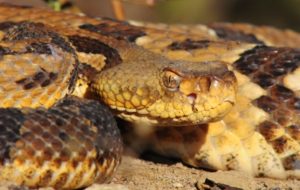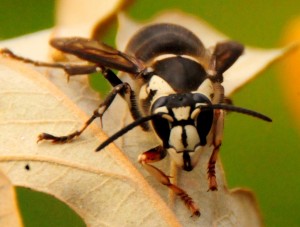Photography courtesy of Lowell Washburn, all rights reserved.
Not All Wildlife Encounters End in Warm Fuzzies
Nothing compares to a day spent in the great out-of-doors. Depending on individual interests, outdoor fun may include hunting, fishing, hiking, canoeing, biking or birding. The list is virtually endless.
But hidden among all that outdoor fun are potential dangers; many of which may take us by complete surprise. Such events often strike without warning, turning a pleasant day’s outing into an immediate nightmare. There are many classic examples.Like the time my friend Don Humburg was duck hunting at Ventura Marsh and, as a final touch of camouflage, hoisted a chunk of muddy cattail root onto his boat deck. Unknown to Humburg, the clump harbored a 2 1/2-inch leather backed, giant water bug which, upon taking offense to being relocated, delivered a painful stab with its hypodermic nose piece. More alarming than the acute pain was the near immediate discoloration and grotesque swelling of Humburg’s arm — swelling that continued to escalate until his arm had attained nearly the same circumference as his leg. The hunt was over and Don ended up spending the afternoon reclining on a hospital bed instead of in the cockpit of his duck boat.
Whenever in snake country, experienced hikers remain on constant lookout for slumbering timber rattlers. Although venomous snake bites are rare to the point of being nearly nonexistent in Iowa, no one wants to become an exception to the rule. It should be noted that nearly all snake bites occur when people intentionally mess with rattlers that are minding their own business and only want to be left alone. Having said that, I also admit to messing with a number of snakes myself.
Although now discontinued, the DNR used to maintain an extremely popular live educational snake exhibit at the Iowa State Fair. Over a 25-year period, I was struck at [but never hit] by several of the exhibit’s timber rattlesnakes. The reptiles were always most vicious when first captured. But once in captivity the large, big-around-as-your-arm adults quickly adjusted. By the time the ten-day fair concluded, the snakes seemed almost “tame” as they were regathered for a return to their woodland homes.
Although venomous bites by giant water bugs or timber rattlesnakes are rare, painful attacks by wasps and hornets are more common. Of all the species included in this large and diverse family none command more respect, inspire greater terror or pack a meaner punch than a spectacular inch-long, black and white insect known as the bald-faced hornet.
Bald faced-hornets are the communal insects responsible for constructing those huge football-shaped paper nests seen hanging from tree limbs and often portrayed in television cartoons. But although hornet nests may provide humorous material for Saturday morning kiddy shows, they are anything but funny when encountered in the wild. Famed for their uncanny ability to deliver large doses of high octane venom and excruciating pain, an active colony is nothing to fool with — especially during late summer when nests attain a peak number of highly motivated protectors.
But although bald-faced hornets will aggressively defend their nests against any and all comers, they do not intentionally go looking for trouble. Most attacks are the result of insects feeling threatened. It really doesn’t matter whether the threat is real or imagined. Once a mass assault is launched, the consequences are virtually unimaginable. Given the choice, I would much rather handle an agitated bluff country rattlesnake than to unknowingly invade the private space of an active colony of bald-faced hornets.
My very first encounter with this legendary species occurred during my high school years when Ed Kotz and I decided to stage a trout fishing expedition into northeastern Iowa’s Yellow River State Forest. It was early summer and we had made camp near the bank of our favorite stream. The weather was perfect and the trout aggressive; recklessly hitting just about anything we chose to throw at them.
There was one notable exception; a thick 20-inch-plus rainbow lying at the head of a dark pool. No matter what we offered, the huge trout refused to budge. That night, after consuming a few of the fish’s smaller relatives, we made plans for a serious crack-of-dawn effort to bag this beguiling trophy.
Morning came and I had just arrived at the pool’s edge when I heard a mournful howl accompanied by somewhat of a commotion back at camp. Turning around, I was amazed to see Kotz exit his tent on a dead sprint for the trout stream. Reaching the bank in record time, he immediately thrust his arm into the icy water.
Hurrying to the scene, I learned that a lone bald-faced hornet had invaded the tent. While in the process of rolling his sleeping bag into a tight bundle Kotz had inadvertently pinned the insect; a situation which had immediately caused the hornet to pin him back.
As Kotz reluctantly pulled his hand from the cooling depths of the stream bed, there could be little doubt as to the focus of the attack. The hornet’s stinger had been driven directly into the outer joint of his thumb which, in addition to emitting pulses of white hot pain, had already began to swell. I could tell by the look on Ed’s face that squeezing a bald-faced hornet into the folds of a sleeping bag was not something I wanted to try for myself.
We never did catch that huge trout, and I can’t tell you much about anything else that happened during the remainder of our trip. But what I do remember with absolute clarity is the sight of what appeared to be a visible heartbeat at the end of Kotz’s discolored thumb.
Although I doubt you could have convinced him at the time, Ed’s encounter was mild compared to most. Our incident involved a single insect in the wrong place at the wrong time. But when anglers, hikers and other outdoor enthusiasts unwittingly cross the line and invade a colony’s personal domain, the scenario becomes much different and the consequences more severe.
Many colonies contain hundreds of workers, and when bald-faced hornets launch an organized attack it has all the ingredients of a never-to-be-forgotten experience. Some of the most dramatic accounts originate from northeastern Iowa where forest lands and paper hornet nests are plentiful. One noteworthy incident involved a caravan of canoeists touring the Upper Iowa River. The first clue of impending disaster occurred when occupants of the lead vessel began wildly waving their arms while screaming at the top of their lungs.
Thoseactions were soon imitated by passengers in the second canoe, followed by the third, and so on. The event culminated with a couple of Eskimo-style canoe rolls and enough floating equipment that the scene resembled a shipwreck. Although the actual site of the hornet’s nest was never discovered, I’m also guessing that no one was putting much effort into the search.
Equally incredible is an account involving a group of school-age boys from the small Mississippi River town of Sageville. After blindfolding a younger friend, a couple of local ruffians equipped the unfortunate lad with a sturdy push pole commandeered from a nearby duck boat. The boy was then encouraged to swing the pole at a low-hanging hornet’s nest in the same manner one would use to open a piñata.
The joke backfired as the angry swarm set fire to the summer sky. The hornets took no prisoners as the blindfolded batter, along with each and every onlooker, became a welt covered victim. The ensuing exchange between parents nearly came to blows.
In spite of their dangerous potential, amazingly few encounters with formidable creatures like timber rattlesnakes, giant water bugs, or bald-faced hornets result in serious human injury. Love them or fear them; there is no denying that these, along with other equally amazing but potentially painful creatures, add a certain measure of intrigue and excitement to Iowa’s wild places and make exploring the great out-of-doors a much more interesting endeavor.



 Tom Cope
Tom Cope Sue Wilkinson
Sue Wilkinson Susan Judkins Josten
Susan Judkins Josten Rudi Roeslein
Rudi Roeslein Elyssa McFarland
Elyssa McFarland Mark Langgin
Mark Langgin Adam Janke
Adam Janke Joe Henry
Joe Henry Kristin Ashenbrenner
Kristin Ashenbrenner Joe Wilkinson
Joe Wilkinson Dr. Tammy Mildenstein
Dr. Tammy Mildenstein Sean McMahon
Sean McMahon